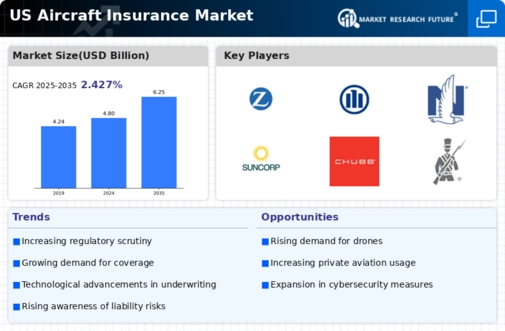Rising Aircraft Ownership
The increasing number of private and commercial aircraft ownership in the US appears to be a primary driver for the aircraft insurance market. As more individuals and businesses invest in aircraft, the demand for comprehensive insurance coverage rises. In 2025, the Federal Aviation Administration (FAA) reported a growth of approximately 5% in registered aircraft, indicating a robust market for insurance providers. This trend suggests that as ownership expands, so does the necessity for tailored insurance solutions that address specific risks associated with different types of aircraft. Consequently, insurance companies are likely to develop more specialized policies to cater to this growing clientele, thereby enhancing the overall landscape of the aircraft insurance market.
Increased Regulatory Scrutiny
The aircraft insurance market is experiencing heightened regulatory scrutiny, which could significantly impact coverage options and pricing structures. Regulatory bodies in the US are continuously updating safety standards and insurance requirements for aircraft operations. This evolving regulatory landscape may compel insurers to adjust their policies to remain compliant, potentially leading to increased costs for policyholders. Moreover, as regulations become more stringent, the demand for specialized insurance products that meet these new standards is likely to rise. Consequently, this driver may create both challenges and opportunities within the aircraft insurance market, as insurers strive to balance compliance with competitive pricing.
Expansion of Aviation Services
The expansion of aviation services, including charter flights and air taxi services, is contributing to the growth of the aircraft insurance market. As these services become more prevalent, the demand for insurance tailored to commercial operations is likely to increase. In 2025, the US aviation sector is projected to see a 10% rise in charter flight operations, which may necessitate specialized insurance products that cater to the unique risks associated with commercial aviation. This trend indicates that insurers must adapt their offerings to meet the evolving needs of the market, potentially leading to innovative policy structures that address the complexities of commercial aviation.
Growing Awareness of Liability Risks
There is a growing awareness among aircraft owners regarding the potential liability risks associated with aircraft operation. This heightened awareness is likely to drive demand for comprehensive liability coverage within the aircraft insurance market. As incidents involving aircraft accidents can lead to substantial financial repercussions, owners are increasingly recognizing the importance of adequate insurance protection. In 2025, surveys indicate that approximately 70% of aircraft owners prioritize liability coverage when selecting insurance policies. This trend suggests that insurers may need to enhance their offerings to address the specific liability concerns of their clients, thereby fostering growth in the market.
Technological Advancements in Aviation
Technological innovations in aviation, such as enhanced safety features and advanced navigation systems, are influencing the aircraft insurance market. These advancements may lead to a reduction in accident rates, which could potentially lower insurance premiums. For instance, the integration of artificial intelligence and data analytics in risk assessment allows insurers to evaluate risks more accurately, thereby optimizing policy pricing. As technology continues to evolve, the aircraft insurance market is likely to adapt, offering policies that reflect the reduced risks associated with modern aircraft. This shift may encourage more aircraft owners to seek insurance, further driving market growth.

















Leave a Comment